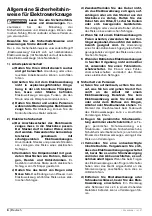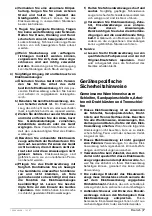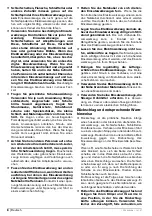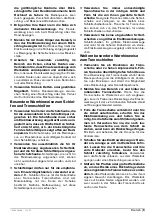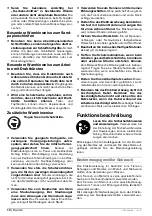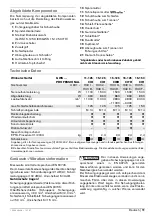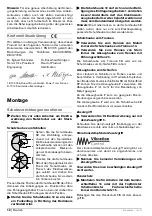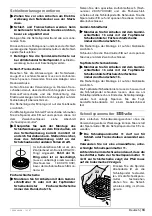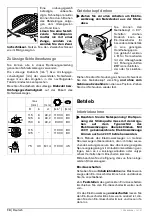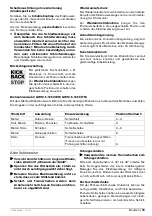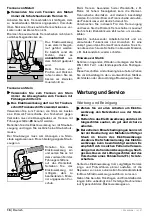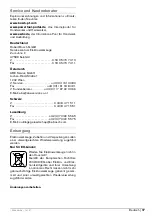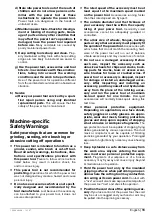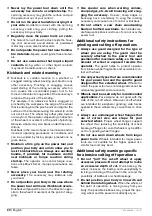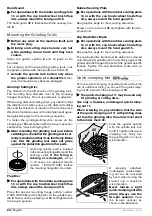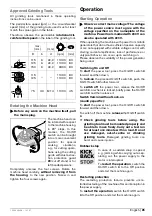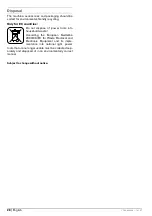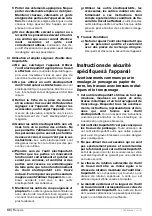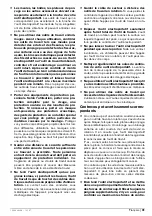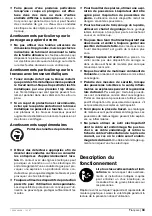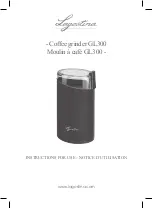
20
| English
1 609 929 L08 • 12.1.07
f
Never lay the power tool down until the
accessory has come to a complete stop.
The
spinning accessory may grab the surface and pull
the power tool out of your control.
f
Do not run the power tool while carrying it at
your side.
Accidental contact with the spinning
accessory could snag your clothing, pulling the
accessory into your body.
f
Regularly clean the power tool’s air vents.
The motor’s fan will draw the dust inside the hous-
ing and excessive accumulation of powdered
metal may cause electrical hazards.
f
Do not operate the power tool near flamma-
ble materials.
Sparks could ignite these materi-
als.
f
Do not use accessories that require liquid
coolants.
Using water or other liquid coolants
may result in electrocution or shock.
Kickback and related warnings
f
Kickback is a sudden reaction to a pinched or
snagged rotating wheel, backing pad, brush or any
other accessory. Pinching or snagging causes
rapid stalling of the rotating accessory which in
turn causes the uncontrolled power tool to be
forced in the direction opposite of the accessory’s
rotation at the point of the binding.
For example, if an abrasive wheel is snagged or
pinched by the workpiece, the edge of the wheel
that is entering into the pinch point can dig into the
surface of the material causing the wheel to climb
out or kick out. The wheel may either jump toward
or away from the operator, depending on direction
of the wheel’s movement at the point of pinching.
Abrasive wheels may also break under these con-
ditions.
Kickback is the result of power tool misuse and/or
incorrect operating procedures or conditions and
can be avoided by taking proper precautions as
given below.
f
Maintain a firm grip on the power tool and
position your body and arm to allow you to
resist kickback forces. Always use auxiliary
handle, if provided, for maximum control
over kickback or torque reaction during
start-up.
The operator can control torque reac-
tions or kickback forces, if proper precautions are
taken.
f
Never place your hand near the rotating
accessory.
The accessory may kickback over
your hand.
f
Do not position your body in the area where
the power tool will move if kickback occurs.
Kickback will propel the tool in the direction oppo-
site to the wheel’s movement at the point of snag-
ging.
f
Use special care when working corners,
sharp edges, etc. Avoid bouncing and snag-
ging the accessory.
Corners, sharp edges or
bouncing have a tendency to snag the rotating
accessory and cause loss of control or kickback.
f
Do not attach a saw chain woodcarving
blade or toothed saw blade.
Such blades cre-
ate frequent kickback and loss of control over the
power tool.
Additional safety instructions for
grinding and cutting off operations
f
Always use guard designed for the type of
wheel you are using. The guard must be
securely attached to the power tool and
positioned for maximum safety, so the least
amount of wheel is exposed towards the
operator.
The guard helps to protect operator
from broken wheel fragments and accidental con-
tact with wheel.
f
Use only wheel types that are recommended
for your power tool and the specific guard
designed for the selected wheel.
Wheels for
which the power tool was not designed cannot be
adequately guarded and are unsafe.
f
Wheels must be used only for recommended
applications.
For example: do not grind with the
side of the cut-off wheel. Abrasive cut-off wheels
are intended for peripheral grinding; side forces
applied to these wheels may cause them to shat-
ter.
f
Always use undamaged wheel flanges that
are of correct size and shape for your
selected wheel.
Proper wheel flanges support
the wheel thus reducing the possibility of wheel
breakage. Flanges for cut-off wheels may be differ-
ent from grinding wheel flanges.
f
Do not use worn down wheels from larger
power tools.
Wheels intended for larger power
tools are not suitable for the higher speed of a
smaller tool and may burst.
Additional safety warnings specific
for abrasive cutting off operations
f
Do not “jam” the cut-off wheel or apply
excessive pressure. Do not attempt to make
an excessive depth of cut.
Overstressing the
wheel increases the loading and susceptibility to
twisting or binding of the wheel in the cut and the
possibility of kickback or wheel breakage.
f
Do not position your body in line with and
behind the rotating wheel.
When the wheel, at
the point of operation, is moving away from your
body, the possible kickback may propel the spin-
ning wheel and the power tool directly at you.
OBJ_BUCH-165-003.book Page 20 Friday, January 12, 2007 9:16 AM
Summary of Contents for GWS 11-125 CIH
Page 3: ...1 609 929 L08 12 1 07 3 ...
Page 154: ...155 1 609 929 L08 12 1 07 ...

